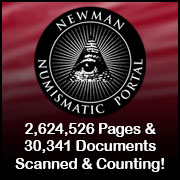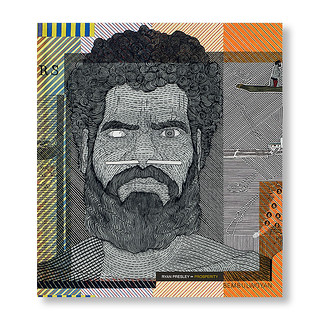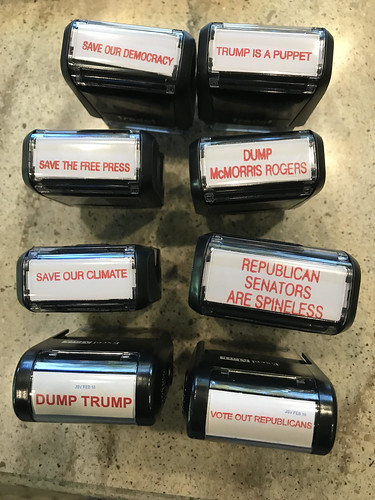
About UsThe Numismatic Bibliomania Society is a non-profit association devoted to the study and enjoyment of numismatic literature. For more information please see our web site at coinbooks.org SubscriptionsThose wishing to become new E-Sylum subscribers (or wishing to Unsubscribe) can go to the following web page link MembershipThere is a membership application available on the web site Membership Application To join, print the application and return it with your check to the address printed on the application. Print/Digital membership is $40 to addresses in the U.S., and $60 elsewhere. A digital-only membership is available for $25. For those without web access, write to: Charles Heck, Treasurer
AsylumFor Asylum mailing address changes and other membership questions, contact Chuck at this email address: treasurer@coinbooks.org SubmissionsTo submit items for publication in The E-Sylum, write to the Editor at this address: whomren@gmail.com BUY THE BOOK BEFORE THE COIN |
- WAYNE'S WORDS: THE E-SYLUM SEPTEMBER 4, 2019
- ASYLUM AUTUMN 2019 ISSUE PUBLISHED
- NEW BOOK: CHINESE COIN AMULETS
- NEW BOOK: PROSPERITY
- 2018 JOURNAL OF ARCHAEOLOGICAL NUMISMATICS
- SHEKEL PRIZE MEDAL AWARDED TO ALEX ABEZGAUZ
- EXHIBIT: BOOKS FOR THE BYZANTINE COIN COLLECTOR
- NEWMAN PORTAL CHAPMAN CORRESPONDENCE UPDATE
- HOW BLIND COIN COLLECTOR READS NEWMAN PORTAL
- VIDEO: GARY ADKINS, FUTURE OF NUMISMATICS
- "G. TRAEBING" TOKEN ASSISTANCE SOUGHT
- JAMES CAGNEY PRESIDENTIAL MEDAL OF FREEDOM
- NOTES FROM E-SYLUM READERS: SEPTEMBER 1, 2019
- 'REPUBLICAN SENATORS' OVERSTAMPED DOLLAR BILLS
- HONG KONG PROTEST SLOGANS ON BANKNOTES
- SILVIO GESELL'S MONEY WITH AN EXPIRATION DATE
- VOCABULARY TERM: DRAG ENGRAVING
- JOHN W. VAN VLEET (1819-1900)
- CHICAGO HALL OF FAME INDUCTS ELSTON BRADFIELD
- PCGS CERTIFIES FIRST 2019-W SAN ANTONIO QUARTERS
- THE FIRST MORGAN DOLLARS STRUCK IN SAN FRANCISCO
- STEPHEN ALBUM RARE COINS AUCTION 35
- LARGE HOARD OF NORMAN SILVER PENNIES FOUND
- MANY BRITISH COINS, BANKNOTES STILL UNREDEEMED
- THE RISE OF CONDER TOKENS
- THE PITT REBUS CONDER TOKEN
- MORE ON THE 'LET THE E[A]GLE FLY' TOKEN
- THEODORE N. VAIL AND THE U.S. POSTAL SERVICE
- THE GREAT BOOK SCARE
- BRISBANE ARTIST RYAN PRESLEY'S BLOOD MONEY ART
Click here to access the complete archive
To comment or submit articles, reply to whomren@gmail.com
Content presented in The E-Sylum is not necessarily researched or independently fact-checked, and views expressed do not necessarily represent those of the Numismatic Bibliomania Society.
WAYNE'S WORDS: THE E-SYLUM SEPTEMBER 4, 2019
 This week is the anniversary of our first
issue, published September 4, 1998! This week we open with a new issue of our print journal, two new books, a journal, a book prize and a prize-winning numismatic literature
exhibit.
This week is the anniversary of our first
issue, published September 4, 1998! This week we open with a new issue of our print journal, two new books, a journal, a book prize and a prize-winning numismatic literature
exhibit.
Other topics this week include the Blind Coin Collector, James Cagney's Medal of Freedom, political overstamps on paper money, money with an expiration date, drag engraving, Elston Bradfield, the first 2019-W San Antonio quarters, the first Morgan dollar struck in San Francisco, Conder tokens, the Great Book Scare and Ryan Presley's Blood Money art.
To learn more about Chinese coin amulets, Jewish banknotes, Byzantine coin books, the Future of Numismatics, priceless books for sale, ISIS coinage, stamp scrip, Norman silver pennies, Theodore Vail, book dust, and the toucan and the two-headed cow, read on. Have a great week, everyone!
Wayne Homren
Editor, The E-Sylum
ASYLUM AUTUMN 2019 ISSUE PUBLISHED
The latest issue of our print journal The Asylum is on the way to the mailboxes of Numismatic Bibliomania Society members. Here is the table of contents and a message from our President Tom Harrison. Another great lineup of articles! -Editor
The Asylum Autumn 2019 edition
 The Asylum
The Asylum
Vol. 37 No. 3
Autumn 2019
Thanks to all members who have been submitting such interesting articles. Keep them coming!
In this issue:
• Message from NBS President Tom Harrison
• Report from the NBS Symposium and NBS Annual Meeting, including The Asylum awards and results of the NBS Annual Benefit Auction By Joel J. Orosz
• Invasion of Champaign By Len Augsburger
• Written History of 1793 Cents By Jim Neiswinter
• Ken Lowe Remembered By Myron Xenos
• Gerald Hart, Canadian Numismatist and Bibliophile By Ted Banning
• A Small Beginning: The First Six Volumes of The Numismatist By Len Augsburger
• The Crondall Hoard By David Pickup
Message from the NBS President
By Tom Harrison
The Numismatic Bibliomania Society's 40th anniversary milestone is now history. It was a great week of biblio fun, education and fellowship. Again this year we hosted the NBS club table that was located between literature dealers Charles Davis and Kolbe & Fanning. The table provided an opportunity for friends of the NBS to view items from Friday's Benefit Auction, receive a commemorative 40th anniversary coffee mug for a $25 donation to the NBS, and most of all, it served as a gathering place to share our passion for the hobby. Throughout the week, members and friends of the NBS stopped by, pulled up a chair and engaged in discussions on a variety of topics. Thanks to Len Augsburger, Joel Orosz and Kellen Hoard for hosting the table.
On Thursday our Symposium featured two outstanding presentations. First we were excited to have NBS Vice President Len Augsburger, provide a fascinating in-depth discussion on the legendary first six volumes of The Numismatist (see article in this issue for more). Also, we were privileged to welcome American Numismatic Society Deputy Director, Dr. Gilles Bransbourg, who gave a presentation on the ANS publication policy and shared other news from the ANS.
Friday's General Meeting included The Asylum author awards and the presentation of the George Fredrick Kolbe Lifetime Achievement Award. The Jack Collins Award for the best article by a first time author was presented to Michael Shutterly for his fine article Buy the Book for the Coin: Books for the Byzantine Coin Collector. The Joel J. Orosz Award for the best article appearing in The Asylum was presented to Joel J. Orosz for his outstanding article Associations: Del Bland's William H. Sheldon-Inscribed Copy of Early American Cents: Before the Sheriff Nabbed the Switcher. The George Fredrick Kolbe Lifetime Achievement Award was last bestowed in 2015. This year the Board awarded this medal to the late Charles Ricard who with his son, Marc, designed and funded the dies for this prestigious medallic award. The meeting also featured presentations by The E-Sylum Editor, Wayne Homren, and Newman Numismatic Portal Coordinator, Len Augsburger, reporting on The E-Sylum and Newman Numismatic Portal respectively.
Again this year, our one major fundraising event, the Benefit Auction, was a success due to many generous donors and enthusiastic bidders stepping up to the plate. The auction, a generous $250 donation and the sale of our 40th anniversary coffee mugs raised nearly $6000 for the NBS! On behalf of the entire NBS membership, I want to share a heartfelt thank you to the donors and bidders and to David Fanning for cataloging the sale and serving as our auctioneer.
Visiting the collector exhibits provided bibliophiles an opportunity to view two outstanding literature exhibits. Conventioneers were treated to an amazing display of rare books related to Napoleonic medals titled The Numismatic Literature of Napoleonic Medals. The other outstanding display demonstrated how a single gold solidus struck by Byzantine emperor Theophilos launched one collector's bibliomania.
The special 40th anniversary week was capped off by a tour of Dan Hamelberg's incomparable library on Sunday. Not only was this an opportunity to visit the most comprehensive private library of American numismatic literature, but it also provided a wonderful day of fun and fellowship. A very special thank you to Dan and his wife Connie and to Len Augsburger who made the travel arrangements.
As a result of many devoted members giving their time, talent and resources, this was an amazing week of NBS enjoyment from start to finish. THANK YOU ALL! May your numismatic library provide investigation, discovery and most of all, enjoyment.
Invasion of Champaign
Following this year's World's Fair of Money, NBS members joined Dan Hamelberg at his home in Champaign, Illinois to explore his numismatic library. Watch a video tour of
this event, produced by Lianna Spurrier, under sponsorship of the Eric P. Newman Numismatic Education Society. (https://nnp.wustl.edu/library/book/567853)
Remember, while The E-Sylum is free to all, only paid members of the Numismatic Bibliomania Society receive our print journal, The Asylum. Print/Digital membership is $40 to addresses in the U.S., and $75 elsewhere. A digital-only membership is available for $25. -Editor
To join NBS, see:
https://www.coinbooks.org/club_nbs_member_app.html
NEW BOOK: CHINESE COIN AMULETS
Here's a new book published in Russia on Chinese Coin amulets. Stephen Album Rare Coins is offering a copy in their Auction 35. Thanks to Mike Barry of SARC for pointing this out for our readers. As noted in the lot description, it's already a rare book. -Editor
 Shevtsov, Sergey
Nikolaevich, Kitayskiye monetovidnyye amulety; Nadpisi, syuzhety, simvoly., "Chinese Coin amulets: Inscriptions, Subjects and Symbols", Moscow, Russia, 2019, 910
pages, hardcover.
Shevtsov, Sergey
Nikolaevich, Kitayskiye monetovidnyye amulety; Nadpisi, syuzhety, simvoly., "Chinese Coin amulets: Inscriptions, Subjects and Symbols", Moscow, Russia, 2019, 910
pages, hardcover.
This book is a study on China's numismatics in the context of traditional Chinese culture. More than 1,800 coin-like amulets, released over the past two thousand years, beginning with the Han era and until the middle of the last century, are described.
An attempt was made to classify the artifacts under consideration into classes and groups based on the semantics of inscriptions, subject matter and artistic symbols. The practice of using coin-like amulets and related customs, the connection of amulets with history, art, and religion are studied, and the characteristics of the use of amulets and talismans in modern China are described.

The book is intended for Russian orientologist numismatists, and for all who are interested not only in numismatics, but also in Chinese traditional culture. It is safe to say that for decades it will become the most important guide on the subject of Chinese coin-like amulets. The publication was prepared using the author's own funds, therefore the circulation is very limited - only 66 copies were printed, of which 16 are mandatorily sent to the Book Chamber of the Russian Federation.
Thus, only 50 copies are available. More precisely, less a copy for the author and copies sold at the All-Russian Numismatic Conference, 45, which immediately makes the book a bibliographic rarity. The book contains more than 1,800 color and 43 black and white illustrations of amulets from various sources, from private collections and from the personal collection of the author; this copy is signed by the author.

To read the complete lot description, see:
Shevtsov, Sergey Nikolaevich; 2019,
"Chinese Coin amulets: Inscriptions, Subjects and Symbols"
(https://www.sarc.auction/Shevtsov-Sergey-Nikolaevich-Kitayskiye-monetovidnyye-amulety-Nadpisi-syuzhety-simvoly_i34100650)
NEW BOOK: PROSPERITY
A new book has been published based on the Blood Money series by Australian artist Ryan Presley. For more information, see the article by Andrew Crellin later in this issue. -Editor
Eds.: Madeleine King
Contributors: Ryan Presley, Tina Baum, Daniel Browning, and Suvendrini Perera
128 Pages
This book presents selected works from Presley's acclaimed Blood Money series, which presents the heroes and warriors of Indigenous history as figureheads on Australian banknotes, alongside documentation of the recent Prosperity exhibition at the IMA.
The hardcover book, edited by Madeleine King, features a chapter by Ryan Presley on the history of the Australian colony's first currency, the holey dollar, alongside contributions by Tina Baum, Daniel Browning, and Suvendrini Perera that explore different manifestations of currency as a tool of the colonial project.
$25.00
Weight: 580 g
Dimensions: 23.6 × 19.2 × 2 cm
For more information, or to order, see:
Ryan Presley Prosperity (https://ima.org.au/product/ryan-presley-prosperity/)
To read the earlier E-Sylum article, see:
AUSTRALIAN ARTIST'S BLOOD MONEY NOTES (https://www.coinbooks.org/v22/esylum_v22n05a32.html)

2018 JOURNAL OF ARCHAEOLOGICAL NUMISMATICS
The latest volume of the multilingual Journal of Archaeological Numismatics has been published. Here's a Google-translated table of contents. -Editor
 THE CHAIRMAN'S
ADDRESS
THE CHAIRMAN'S
ADDRESS
Jean-Marc Doyen
Prospections and megacontexts: reflections on the good (?) Use of detectors of metals in archeology V
ARTICLES
Richard Reece
Roman coins in Malta
Jean-Marc Doyen
The spatialization of monetary deposition rituals: a re-reading of the site of Castellains in Fontaine-Valmont (Hainaut, Belgium)
Bruno Callegher, Anna Maria Larese and Luca Rinaldi with the collaboration di Elena Baracchini, Matteo Crosera, Enrico Prenesti and Gianpiero Adami
A votive deposit on the ridge of Trevigiane-Belluno Prealps: the excavation archaeological site of Mount Cesén, numismatic findings and archaeometric analysis
Patrick Biellmann, Diamantino Gil & Thierry Kilka
From Late Antiquity to the High Middle Ages: Late-Century Coins and Altomédieal of Oedenburg (Biesheim-Kunheim, Alsace, France)
Jens Christian Moesgaard
Reconstructing the context of a metal detector finds from top soil. A case study of the redundant / abandoned churches of Oldrup and Uld, Jutland, Denmark
Jerome Jambu
The coins of Fort San Sebastián de Saint-Germain-en-Laye. The sale troops of Louis XIV in question
NOTICES
David Martínez Chico
The monetary deposit of Calle del Mar, 19 (Valencia)
Thomas Matthews Boehmer
Coin mints and coin circulation: a debate about the meaning of 'tribe' in Late Iron Age Norfolk
Murray Andrews
Flemish coins in mid-late fourteenth century England and Wales: distribution, chronology, and use
Ermanno A. Arslan
A necropolis of and giulio-claudia discovered in the 19th century in Biassono (Monza-Brianza, Italy)and the use of moneta spezzata nel rito dell'obolo di Caronte
Jean-Patrick Duchemin
Trajan dupondii cast imitations: a complement
FOLDER
Jean-Marc Doyen
An introduction to Richard Reece's Journeys for Roman Coins
Richard Reece
Journeys for Roman Coins: "Coins, Archeology and History in France" followed by an "Italian Travelogue"
REVIEWS
Alejandro G. Sinner - The ceca of Ilduro (Manuel Gozalbes)
Frédérique Duyrat & Catherine Grandjean (ed.) - The search coins of the Greek world (6th-1st century BC). Contributions, approaches and methods (Pierre-Marie Guihard)
Nanouschka Myrberg Burström and Gitte Tarnow Ingvarson (eds) - Divina Moneta. Coins in religion and ritual. Religion and Money in the Middle Ages 2 (Jean-Patrick Duchemin)
Günther E. Thüry - The antique coin as a find object. Categories numismatic Finds and their interpretation (Jean-Marc Doyen)
To read the complete issuee, see:
The Journal of Archaeological Numismatics - Vol 8
(https://www.academia.edu/37679028/The_Journal
_of_Archaeological_Numismatics_-_Vol_8)
SHEKEL PRIZE MEDAL AWARDED TO ALEX ABEZGAUZ
The Shekel Prize Medal has been awarded to the Late Alex Abezgauz for the book Jewish Banknotes Based on the Collection of A. Abezgauz. Here's the press release, to which I've added images of the book. -Editor
Shekel Prize Medal Awarded to the Late Alex Abezgauz at NLG Award Luncheon
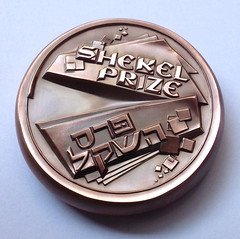

 The Shekel Prize Medal is
awarded annually by the American Israel Numismatic Association to the author of the best book on the subject of Judaic or Holy Land numismatics. This year's winner, Alex Abezgauz,
was announced at the NLG luncheon, held at the ANA's World's Fair of Money convention. The late Alex Abezgauz's prize-winning book "Jewish Banknotes Based on the Collection of A.
Abezgauz," was compiled by ?.V. Paramonov, with the participation of Alex's son Daniel and Alex's wife Ellen. Ira Rezak, member of AINA's Board of Directors and friend of Alex,
will present the award to Alex's son Daniel later this year.
The Shekel Prize Medal is
awarded annually by the American Israel Numismatic Association to the author of the best book on the subject of Judaic or Holy Land numismatics. This year's winner, Alex Abezgauz,
was announced at the NLG luncheon, held at the ANA's World's Fair of Money convention. The late Alex Abezgauz's prize-winning book "Jewish Banknotes Based on the Collection of A.
Abezgauz," was compiled by ?.V. Paramonov, with the participation of Alex's son Daniel and Alex's wife Ellen. Ira Rezak, member of AINA's Board of Directors and friend of Alex,
will present the award to Alex's son Daniel later this year.
Alex Abezgauz was a physicist trained in Russia who was also a pre-eminent collector of Russian banknotes. He assembled an impressive collection of Jewish related banknotes and emergency currencies of Russia, some 400 or 500 items which is a major resource for the history of the Jews in Russia, principally during the Russian Revolutionary period. Alex died a few years ago and his son arranged for the collection to be published in English and Russian, with every note illustrated in color, and with a certain amount of contextual historical information.
More information about the Shekel Prize and the American Israel Numismatic Association can be found on AINA's website www.theshekel.org .


For more information on the book, or to purchase, see:
JEWISH BANKNOTES Based on the collection of A.Abezgauz Book (english) 2018 P 216
(https://www.mcoin.ru/eng/catalog/goods/13/8/454/24115/)
JEWISH BANKNOTES Based on the collection of A.Abezgauz
Book (english) (24115) (https://www.ebay.com/itm/JEWISH-BANKNOTES-Based-on-the-collection-of-A-Abezgauz-Book-english-24115/192553455875)
EXHIBIT: BOOKS FOR THE BYZANTINE COIN COLLECTOR
Michael T. Shutterly writes:
"About two years ago, just after the ANA World's Fair of Money in Denver, Maria Fanning issued a call to NBS members to submit articles for The Asylum. At the same time, Wayne noted in The E-Sylum that there had not been a single Numismatic Literature exhibit on display at that year's World's Fair of Money, and he further noted that this was an ongoing problem. As it happens, I enjoy writing. As it happens, I also enjoy putting on numismatic exhibits. So I thought, what the heck, why not kill two birds with one stone? I decided to write an article for The Asylum which I would then turn into an exhibit for the ANA. Maria published the article in the Spring 2018 Asylum as "Buy the Book for the Coin: Books for the Byzantine Coin Collector," and I displayed the exhibit at the ANA as (more simply) "Buy the Book for the Coin."
"So... at last month's World's Fair of Money, the exhibit received the Aaron Feldman Memorial Award for First Place in the Class "Numismatic Literature," and on the very same day the NBS gave the article the Jack Collins Award for Best Article by a First Time Author (and a really cool award it is). What a deal! Especially because I was not expecting either award.
"Anyway, I wanted to thank Maria for the inspiration to write the article, and Wayne, for the inspiration to create the exhibit. Those of us who write on numismatic topics and/or create numismatic exhibits (mostly) do not do it for the sake of winning awards – we do it for the satisfaction and enjoyment of researching something, learning something we did not know, and then sharing it with other like-minded folks; winning an award for that is just icing on a very tasty cake."
Congratulations on both counts - it was a great article and exhibit. I hope this encourages other readers to try their hand at this in the coming year. Next year's WFOM will be held in Pittsburgh, PA.
We have a page on our NBS website that tracks winning exhibits, and for some of them we have the full text and images. Mike kindly provided the text (thanks!) and our webmaster Bruce Perdue will combine these with my photos to memorialize the exhibit.
Here's a preview of my images for those unable to attend the show. Sorry for the glare from the overhead lights - that can be really hard to avoid. -Editor
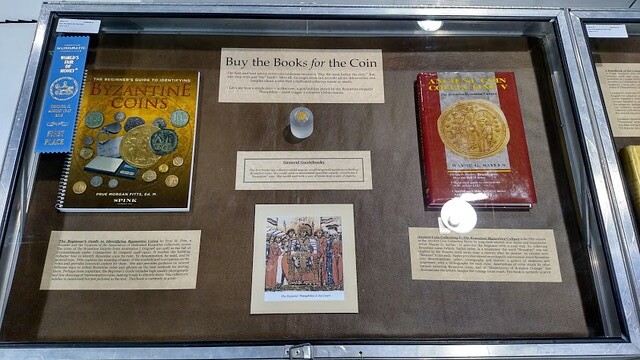
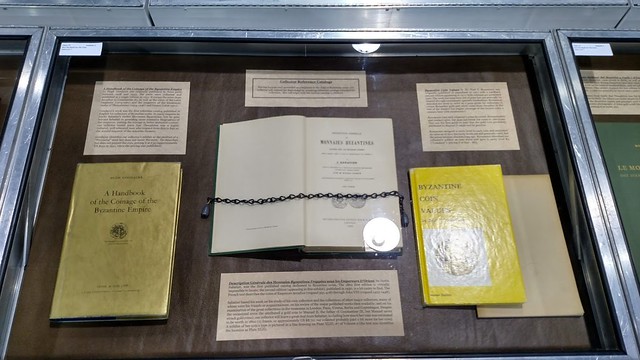
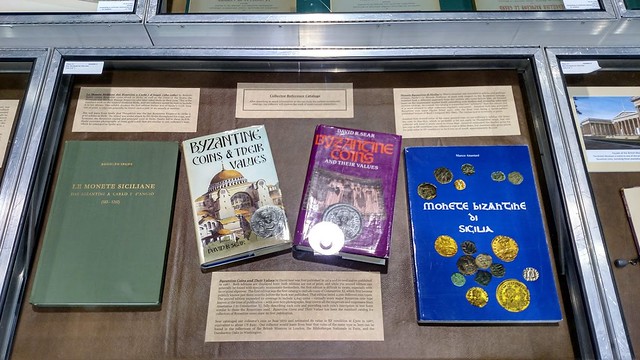
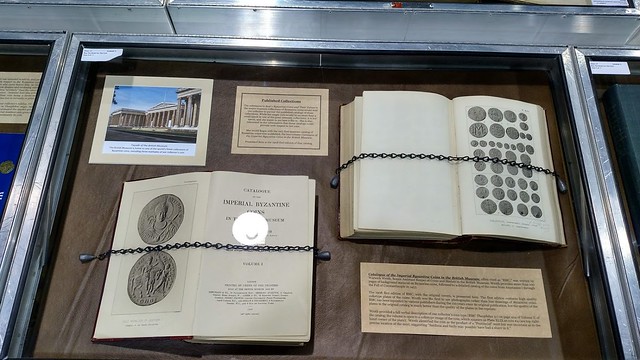


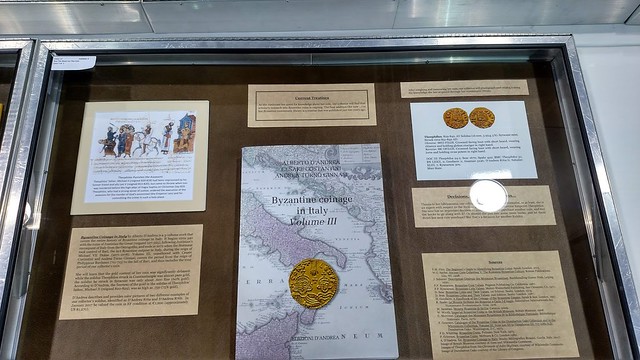
To view the NBS Numismatic Literature Exhibits page, see:
Numismatic Literature Exhibits : The Aaron Feldman Award
(https://www.coinbooks.org/about/exhibit_winners.html)

NEWMAN PORTAL CHAPMAN CORRESPONDENCE UPDATE
The Newman Numismatic Portal is still hard at work digitizing Chapman correspondence. Project Coordinator Len Augsburger provided the following report. -Editor
Newman Portal Continues Digitization of Chapman Correspondence at American Numismatic Society

One of the treasures of the American Numismatic Society archival collection is a group of business correspondence of Samuel Hudson and Henry Chapman, Philadelphia coin dealers c. 1880 to 1930. This tranche of letters provides an insider's view of the coin business for the period. An example is the file of William Dickinson, a St. Louis numismatist. Negotiation is a timeless thing, and Dickinson's missive of March 12, 1892, complaining about consignment rates well illustrates the point:
"…in regard to the sale my Coins, I am appalled by the fact that at your terms proposed for disposing of them every half dollar must realize 67 cents in order for me to obtain its face value, whatever the cost to me may have been….shall I not better dispose of them here at private sale….many of the pieces I took of you paying you 10% [apparently referring to a buyer's commission]. Now if by you sold I must pay 25%, making 35% for me, more than one third this cost to me. I shall lose less by selling them here…..I feel I am paying pretty dear for a defunct whistle to pay 35% for indulgence in this fad….you can appreciate the occasion of my hesitation to sell at auction…."
Dickinson eventually came to terms with the Chapman firm, and his named sale was presented by the Philadelphia brothers in March, 1894. Newman Portal acknowledges David Hill, ANS Librarian, and Lara Jacobs of Internet Archive for their assistance with this project.
Image: Cover for the March 12, 1892 correspondence from Dickinson to the Chapman's.
Link to Chapman / Dickinson correspondence:
https://archive.org/details/dickinsonwilliam00dick/page/1
Link to Chapman sale of Dickinson collection on Newman Portal:
https://nnp.wustl.edu/library/auctionlots?AucCoId=21&AuctionId=510861
HOW BLIND COIN COLLECTOR READS NEWMAN PORTAL
E-Sylum reader Tom Babinszki is blind and publishes the Blind Coin Collector blog. His most recent post describes his difficult but ultimately successful quest to be able to read all numismatic books (even protected in-copyright publications) from the Newman Numismatic Portal, which uses the Internet Archive for digitization and back-end hosting. Here's an excerpt. -Editor


LEFT: Tom's second generation Victor Reader Stream device
RIGHT: Tom visiting the National Numismatic Collection in 2016
The Internet Archive, Archive.org contains almost two million books which are protected, but are freely available for people with print disabilities. Most of these protected books are not available electronically from other places. However, accessing these materials is not immediately obvious. In this post I will describe the problem, and how to get around it.
Though this blog is about coin collecting, this is a topic which can be useful for all people with print disabilities, such as blind, visually impaired or dyslexic. Therefore, I will talk about the issue in general, and at the end I will explain how these protected materials relate to numismatics in general. For the time being, let me just say that it has opened a new world in numismatic research.
Why free books?
In general, people with print disabilities are not immediately able to pick up a book or a magazine and read it. They have to first convert it into electronic format. These days,
most published materials already exist in electronic format, so when they are printed, blind people use a phone app or a scanner and OCR to convert this material back into the
same electronic text, usually in a slightly worse format than the original. It would only make sense to have access to the original electronic resource.
Reading books for free
Before someone gets access to freely available books, they have to provide a proof of disability. There are several organizations which provide access to hundreds of thousands of
books, such as BookShare, or the National Library Service. Though BookShare charges a nominal fee for the service, they also ensure that people can get to these materials even if
they don't have an annual $50.
Once eligibility is established, people can read these books on their computers, mobile devices, or on electronic readers, specially designed for people with print disabilities.
The National Library Service distributes a book reader free of charge, to all eligible people to use. These devices can read from a specially designed cartridge or a USB memory stick.
One of the formats Archive.org uses is DAISY (Digital Accessible Information SYstem), which the NLS reader, many other devices, and applications support. However, when these books are protected, reading them is not as simple as typing the password for access.
Why is Archive.org important?
People with print disabilities these days have many choices when it comes to finding electronically available books. The most important sources are BookShare, the National Library
Service, or Amazon, where for a small fee, people can read Kindle books electronically, most of which are fully accessible. However, Archive.org contains many publications which
are not available anywhere else. At the time of writing, according to Archive.org, they have more than 1,985,000 protected publications.
Protected books and numismatics
There is a web site, the Newman Numismatic Portal, which alone changed what numismatics means to me. Though I've been collecting coins since I was six, I couldn't find much
information about coins. When things started to change was when the online coin catalogs started to appear, I first got a subscription in 2008. But the Newman Numismatic Portal in
the last few years made research more imaginable without vision than ever before. Of course, it is always possible to get books and magazines and scan them one by one. But this is
where the NNP helps.
It is an initiative that gathers and digitizes numismatic information. In their own words, "NNP is dedicated to becoming the primary and most comprehensive resource for numismatic research and reference material".
Indeed, they have hundreds of books, thousands of periodicals and auction catalogs just to name a few things.
But here is where it gets interesting for print disabled people. The NNP also digitizes books which are under copyright protection. This way, these books become searchable, but cannot be downloaded. However, the digitized books are housed on Archive.org, and the books under copyright are readable for people with print disabilities as protected DAISY documents.
Currently, there are close to 7,000 numismatic documents in this format. This collection allows me to get some of the latest information about numismatics which sighted people need to read from paper based books and magazines when they find the information they are looking for through the online search.
You can find these lists here:
- Restricted materials from the American Numismatic Society
- All other restricted materials by the Newman Numismatic Portal
Currently I am doing an extensive research, mostly dealing with contemporary literature. When I searched on my main keyword only among the protected documents, I found over a hundred results. This is information I would not be able to find anywhere else, it would have taken me months of research just to compile this list, not to mention that I would still have to obtain the literature from libraries and scan them one by one. Today, when I am interested, I just run a search, download the book, copy it over to my Victor Reader, and read and search the material.
The opportunity the NNP and Archive.org has opened to me is incredible. I hope this information will help other people with print disabilities to explore and use this immense amount of literature.
To read the complete article, see:
Accessing protected DAISY documents on Archive.org
(https://blindcoincollector.com/2019/08/31/accessing-protected-daisy-documents-on-archive-org/)
VIDEO: GARY ADKINS, FUTURE OF NUMISMATICS
These are selections from the David Lisot Video Library that feature news and personalities from the world of coin collecting. David has been attending coin conventions since
1972 and began videotaping in 1985. The Newman Numismatic Portal now lists all David's videos on their website at:
https://nnp.wustl.edu/library/multimediadetail/522852
Here's one on the Future of Numismatics Symposium from last month's ANA World's Fair of Money. -Editor
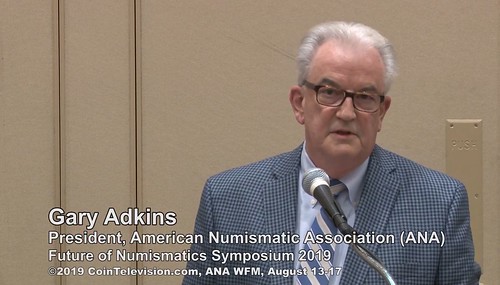 Future of Numismatics
Symposium: Gary Adkins
Future of Numismatics
Symposium: Gary Adkins
Gary Adkins, President, American Numismatic Association
VIDEO: 6:01.
An excerpt of the video is available for viewing on the Coin Television YouTube Channel at:
https://youtu.be/BKKVtHXWz5s
This video is a highlight from Future of Numismatics Symposium: What the Future Hold
Donn Pearlman, Moderator, David Lisot, Video Producer, CoinTelevision.com.
At the 2019 World's Fair of Money the American Numismatic Association asked some of the coin industry's most influential leaders about what they believe is in store for the
future of the hobby. Hear these titans of numismatics share what they believe the future holds.
ANA19-002
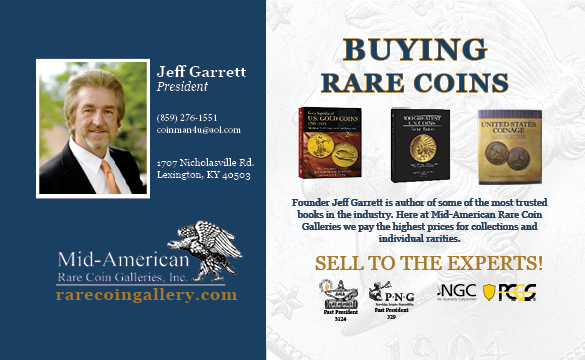
"G. TRAEBING" TOKEN ASSISTANCE SOUGHT


Bill Miller writes:
I have done well with your readers in the past so I would like to request another inquiry regarding one of my tokens.
Steve Tanenbaum told me years ago that the "G. Traebing" token was listed in an 1866 auction catalog. I have searched the Newman Numismatic Portal, and while some listings appear in later catalogs I have found nothing in any 1866 catalogs.
I wish to write an article about it and other tokens which share the same Liberty Head obverse, but cannot until I first find this elusive reference. Any help would be appreciated


Interesting puzzle. Can anyone help? -Editor
JAMES CAGNEY PRESIDENTIAL MEDAL OF FREEDOM
Inspired by last week's article about the Presidential Medal of Freedom, Tony Terranova writes, "I thought readers might get a kick out of seeing this." From his personal collection, it's actor Jimmy Cagney's PMOF. Thanks! It was awarded March 26, 1984 by President Reagan, a fellow movie actor who costarred with Cagney in the 1938 film 'Boy Meets Girl'. -Editor



To read the earlier E-Sylum article, see:
BOB COUSY AWARDED MEDAL OF FREEDOM (https://www.coinbooks.org/v22/esylum_v22n34a23.html)
To read Gene Siskel's bio of Cagney in the Chicago Tribune, see:
MOVIE LEGEND JAMES CAGNEY DIES
(https://www.chicagotribune.com/news/ct-xpm-1986-03-31-8601230786-story.html)
NOTES FROM E-SYLUM READERS: SEPTEMBER 1, 2019
More on Peter Gaspar
David Gladfelter writes:
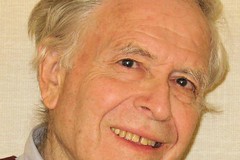 I just wanted to call our readers' attention to
an important contribution by Professor Gaspar. He, together with G. P. Dyer, wrote the thorough and highly readable chapter on "Reform, the New Technology and Tower Hill,
1700-1966" in A New History of the Royal Mint edited by C. E. Challis and published by Cambridge University Press in 1992.
I just wanted to call our readers' attention to
an important contribution by Professor Gaspar. He, together with G. P. Dyer, wrote the thorough and highly readable chapter on "Reform, the New Technology and Tower Hill,
1700-1966" in A New History of the Royal Mint edited by C. E. Challis and published by Cambridge University Press in 1992.
For most of us, numismatics is a hobby. For Dr. Gaspar it was a discipline.
Thanks. He will be missed. -Editor
To read the earlier E-Sylum article, see:
PETER GASPAR (1935-2019) (https://www.coinbooks.org/v22/esylum_v22n33a07.html)
The Bookseller's Lament
Regarding his offerings of rare high-end numismatic literature at the recent American Numismatic Association World's Fair of Money, Gil Parsons of Parsons Books writes:
I do think that some of it was quite new to many, and the result was frequently most interesting: one could sometimes see "the lightbulbs flashing".
On the other hand, I collected a few choice vignettes from browsers, which I include largely to prove connoisseurship of the follies and foibles of casual observers: "This is all very interesting, but I have so little time for knowledge." "Thank you for letting us see your collection" (at which point the bookseller realizes that his function is purely as a fashion accessory-LOL!). "This is really rather more than I would like to spend for decoration." "This should all be in a museum" (To which the snarky bookseller responded-- "You sir are uniquely positioned to make that happen."). Or, my favorite: "These things are priceless" ("Trust me, madam, they are all priced...")
(sigh) It is a sad fact of life in numismatics and elsewhere that there are quite a few people out there who would in a heartbeat drop 4, 5, 6 or more figures on a rare coin or artwork but who couldn't be bothered to spend a dime on a book of any sort, rare or otherwise, even if it would teach them something about the objects they're spending far more dough on. It's a selective, voluntary blindness I've never been able to comprehend. But I'm glad those twits are out of the market and aren't driving up prices for the rest of us who do appreciate the value in a fine book. -Editor

Gil adds:
For several years we were one of the featured booksellers at the San Francisco Fall Antiques Show. The show was (but alas no longer is) one of the very best shows in the world; dealers brought the finest items from their specialties, sometimes with seven figure price tags; some dealers (ourselves occasionally included) built sets for their booths. As you have noticed, especially from our Anniversary Catalogue, we tend to describe items extensively; punters deserve a bit of learned chat if they are contemplating such purchases, not to mention that doing such descriptions is actually FUN!
But yet, some books are so well known that one need not say much at all. Something like:" Newton's Principia, contemporary binding, $400,000". One such book is Matisse's Jazz, one of the very greatest modern illustrated books, endlessly reproduced and known to virtually everybody, if not in its entirety then from prints of individual images. We had a lovely example one year. Amidst other books with page long descriptions, our write-up for Jazz read, in its entirety: "Matisse, Henri. Jazz Paris, Teruel, 1947. In a designer binding Nice Copy. $285,000".
Two women stared intently at the book. One said "This is one of the most beautiful books I have ever seen." The other: "You know, $285,000 doesn't seem at all unreasonable for Jazz". The first: "Yes, but it says it is a copy." So, even at the top end of things, we are not spared such displays...
There was another moment when two folks stared at the Callot Siege of La Rochelle (which is in the catalogue...) arguing with one another about which part of San Francisco Bay was represented--no I'm not kidding!!! And on it goes...
To read the earlier E-Sylum article, see:
PARSONS BOOKS FIXED PRICE LIST OFFERED (https://www.coinbooks.org/v22/esylum_v22n34a03.html)
More on ISIS Coinage
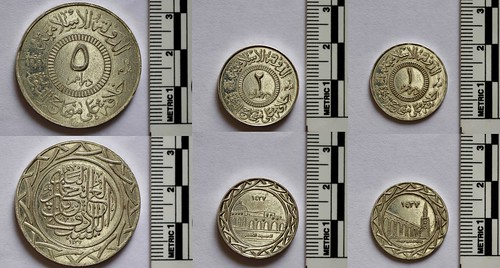
5, 2 and 1 dirham coins dated 1437 (Oct 2015-Oct 2016)
Web site visitor Dan Claassen of California writes:
I obtained ISIS coins matching the 5/2/1 Dirham coins … from someone who was embedded with the SDF (Syrian Democratic Forces) over the past year. I also have a copper "25" which is almost, but not quite identical to the one pictured. What's the denomination of the copper, do you know? Not dirhams..
To read the earlier E-Sylum article, see:
NEW IMAGES OF ISIS COINAGE (https://www.coinbooks.org/v21/esylum_v21n05a24.html)
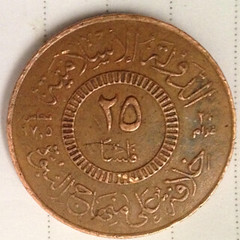

The E-Sylum article Dan referenced is linked above. The copper denominations are "fils"
This is the most recent and probably most accurate article on the ISIS coins:
AN ANALYSIS OF ISIS COIN PRODUCTION
https://www.coinbooks.org/v21/esylum_v21n52a10.html -Editor
Web site visitor Dr. Robert Younes writes:
Recently, ISIS minted coins for the Caliphate. Is there a legitimate source for a collector to acquire a set of these coins?
None that I'm aware of, unfortunately. I procured my ISIS coins from someone who, like Dan's contact, was (or claimed to have been) embedded with forces (in my case, YPG forces) liberating ISIS-controlled areas of Syria. -Editor
More to Come: Encyclopedia of Mexican Money
Tom Bridgeman writes:
 I am wondering if anything will
come out of Don Bailey's Encyclopedia of Mexican Money series, since his passing? I have Volume 1 and 2, and am wondering if the series will be continued or was volume
2, the end of the 'project'?
I am wondering if anything will
come out of Don Bailey's Encyclopedia of Mexican Money series, since his passing? I have Volume 1 and 2, and am wondering if the series will be continued or was volume
2, the end of the 'project'?
I reached out to Dennis Tucker of Whitman Publishing for comment. -Editor
Dennis writes:
Don's passing was a blow to Mexican numismatics. The amount of knowledge he held was amazing. We do plan on continuing the Whitman Encyclopedia of Mexican Money . . . . but I can't give a firm publication date at the moment.
To read earlier E-Sylum articles, see:
NEW BOOK: ENCYCLOPEDIA OF MEXICAN MONEY (https://www.coinbooks.org/esylum_v17n39a02.html)
NEW BOOK: ENCYCLOPEDIA OF MEXICAN MONEY, VOL 2 (https://www.coinbooks.org/esylum_v18n24a02.html)
John S. Queen (1922-2019)
Pete Smith writes:
I enjoyed a series of articles written by John S. Queen and published in Numismatic News during 2011-2012. He wrote his recollection of starting a business in 1974 and dealing primarily in high grade Canadian coins. He conducted one auction in 1978 under the name of Royal Enterprises. In 1979 he quit the business and joined the Peace Corps. Later he went into the Ministry.
I learned from The Numismatist that he died on July 16, 2019. He had been born on October 28, 1922 and was 96 years old. I recall that he worked for Paramount. At one time I was interested in all the Paramount crew and how they were dispersed across many other coin companies.
Did any of our readers know Queen? Any other stories to share? -Editor

'REPUBLICAN SENATORS' OVERSTAMPED DOLLAR BILLS

In my Numismatic Diary last week I pictured the above bill received in change at the ANA World's Fair of Money snack stand and asked, "Was somebody going around spending these at the show?" -Editor
"Glad you got one of my stamped bills in change at the ANA. Please spend it so 799 more people will get it in change and see it. I was at Jack In the Box the other day and the server mentioned he has seen some stamps in green. I have only used red, so someone else is doing this too.
"I've passed them out in front of Trump Tower the last two years and will do it again in January when we go to NYC for a week. Even had some young girls want their picture with this old guy."
Groupies for banknote-stampers? I've seen very few of these in the wild from either political side, but I'm sure many more are coming. Tom shared these photos - he's got plenty more where my note came from. -Editor

It's great to get a first-hand report on how these are getting into circulation. But please - let's keep the discussion on numismatics. As the U.S. election season gets in full swing I'm sure we'll see many more of these from members of both major political parties. We welcome images and stories of stamped notes from the other side, and have already published images of "Donald Trump Lives Here", "Responsible Gun Owner" and "No Obama" stamped notes - see the links below. -Editor
To read the earlier E-Sylum articles, see:
TRUMP SLOGAN ON $20 BILLS (https://www.coinbooks.org/v21/esylum_v21n20a35.html)
MORE ON POLITICAL SLOGANS ON BANKNOTES (https://www.coinbooks.org/v21/esylum_v21n21a16.html)
WAYNE'S 2019 ANA DIARY: PART II : Thursday, August 15, 2019
(https://www.coinbooks.org/v22/esylum_v22n34a20.html)
HONG KONG PROTEST SLOGANS ON BANKNOTES
Banknote stamping is a form of protest in the current unrest in Hong Kong. Kavan Ratnatunga forwarded this article about Thai banks refusing to accept such overstamped notes, in deference to the Chinese government. -Editor

Two popular money exchange services in Thailand said Friday they don't accept Hong Kong banknotes printed with political messages related to the ongoing protests.
Employees at Superrich Thailand and Superrich 1965 said that they won't buy such banknotes from clients because they cannot resell them to Thai commercial banks. Any Thai travelers who possess stamped banknotes were advised to exchange them in Hong Kong.
In an online post published by Superrich 1965 ("the orange Superrich"), the firm shows examples of three "anti-government messages" stamped onto Hong Kong banknotes.
The messages appear to read "Hong Kong independence," "Oppose Communist Party and save the country," and "Return the sovereign power to the people."
To read the complete article, see:
THAI EXCHANGERS BAN HK MONEY STAMPED WITH ‘ANTI-GOVT'
SLOGANS (http://www.khaosodenglish.com/politics/2019/08/23/thai-exchangers-ban-hk-money-stamped-with-anti-govt-slogans/)
SILVIO GESELL'S MONEY WITH AN EXPIRATION DATE
Banknote-stamping is nothing new, of course. In fact, stamps-on-money was a key part of a scheme proposed in 1891 by a self-taught radical economist. National Public Radio's Planet Money published a very interesting article about it. Found via SPMC News & Notes Volume V, Number 10 August 27, 2019. Here's an excerpt. -Editor
 Silvio Gesell hated money. A German entrepreneur who moved
to Argentina for business in the late 19th century, he witnessed a massive financial crash in 1890 that convinced him that money was behind the world's economic problems:
poverty, inequality, unemployment, stagnation.
Silvio Gesell hated money. A German entrepreneur who moved
to Argentina for business in the late 19th century, he witnessed a massive financial crash in 1890 that convinced him that money was behind the world's economic problems:
poverty, inequality, unemployment, stagnation.
The problem, Gesell believed, was that money served two roles that often came into conflict: It was a way for people to store wealth, and it was the thing everybody needed to conduct business. The fact that money could store wealth meant its holders had a reason to cling to it, especially in crises like the one he saw in Argentina, when opportunities to safely put that money elsewhere looked grim. It was a typical story. When people got scared, they hoarded cash and brought business to a standstill. It led, Gesell said, to a situation of "poverty amid plenty."
Gesell wanted to create a new kind of money — a money that would "rot like potatoes" and "rust like iron" so no one would want to hoard it, a money that was "an instrument of exchange and nothing else." And the crazy part is that he did create it. Through a series of pamphlets, articles and books, Gesell inspired a worldwide movement that introduced a completely new form of money. It's one of the most fascinating, and largely forgotten, stories in economic history.
But after 70 years of obscurity, Gesell is making a comeback. All of a sudden, this obscure radical from another age has his name and ideas popping up in unlikely places — like speeches of leaders at the U.S. Federal Reserve, research papers of the International Monetary Fund and the pages of the Financial Times. As the industrialized world grapples with stagnation and as markets signal another recession, policymakers are struggling to figure out what to do. Could Gesell provide an answer?
Money with an expiration date
Gesell was born in 1862 to a German father and a French mother, and he was raised in what is now Belgium. Back then, it was part of the expanding Prussian empire. At 24, he moved
to Buenos Aires, Argentina, where he worked as an importer and manufacturer and did well for himself. On the side, he taught himself economics.
In 1891, hoping to end the depression in Argentina, Gesell published his first work, "Currency Reform as a Bridge to the Social State." He proposed a new kind of paper money that would have an expiration date. To avoid expiration, the bills would have to be periodically stamped for a fee. With no new stamp, they would become worthless. In this system, saving money would cost you money. Savings, in other words, would have a negative interest rate. Only by spending or investing it would you be able to avoid stamp fees.
Gesell called it "free money" (or Freigold) — "free" because he believed it would be freed from hoarding and also because it would encourage bankers to lend money without charging interest. The logic was this: If you're holding on to something that's dropping in value, you'll happily part with it — even if it means that it won't make you more money than you started with. It's like a game of hot potatoes. You want to pass it on. Gesell believed this would keep money whizzing through the system, preventing future depressions and increasing public prosperity.
It was a completely radical idea, especially during a time when nations were on the gold standard. That system latched money to the stable value of gold, which meant currency was a pretty safe place to store wealth. Gesell was saying he didn't want money to be like gold. He wanted it to be like most other objects, which decay and rust and go bad. Of course, many people hated this idea, especially people with a lot of money.
I was about to add a comment that this sort of thing was done in the Great Depression, when the article tied that fact back to Silvio Gesell. -Editor
Free money becomes real money
For decades, money that expired unless stamped was mostly a theory. It took the Great Depression to make it a reality. As the economy went into a free-fall, people scrambled to
find solutions. And in towns scattered throughout Europe and the United States, they found their solution in Gesell. The money reformer, who died in 1930 of pneumonia, would not
live to see it.
In 1932, in the small town of Wörgl, Austria, a town leader, Michael Unterguggenberger, got Wörgl to issue stamped money as a way to combat skyrocketing unemployment and business closures. The town used it to pay the unemployed to do public works, and by all contemporary accounts, the system worked to lift the town out of misery.
The press dubbed it the "miracle of Wörgl," and it was one in a series of local experiments with stamped money. These experiments inspired many other struggling cities, like Hawarden, Iowa, and Anaheim, Calif., to do the same. It was around then that Gesell's work was finally published in English. With classical economics discredited by the prolonged depression and with leading economists scrambling to figure out what to do, many were inspired by Gesell. Among them were Irving Fisher and John Maynard Keynes, two of the most influential economists of the 20th century.
In 1933, Fisher wrote a short book inspired by Gesell's ideas called Stamp Scrip. Fisher was an economist at Yale University, and he's now somewhat unfairly remembered for making overly optimistic predictions before the crash of 1929. He lobbied Congress to institute stamped money to provide relief to a distressed America. U.S. senators introduced a bill (S. 5125) that would have issued a billion dollars of stamped money to be distributed nationally. But it did not end up becoming law. Perhaps that's because that year was already seeing huge changes, with newly elected President Franklin D. Roosevelt implementing the New Deal and taking the U.S. off the gold standard.
To read a digital copy of Stamp Scrip, see: STAMP SCRIP By Irving Fisher, LL.D. (Professor of Economics, Yale University) Assisted by Hans R. L. Cohrssen and Herbe... (https://epdf.pub/stamp-scrip.html)
To read the complete article, see:
The 'Strange, Unduly Neglected Prophet'
(https://www.npr.org/sections/money/2019/08/27/754323652/the-strange-unduly-neglected-prophet)

VOCABULARY TERM: DRAG ENGRAVING
Dick Johnson submitted this entry from his Encyclopedia of Coin and Medal Terminology. Thanks! I'd never heard of this term. Interesting. -Editor
Drag Engraving. A form of flat machine engraving in which the cutter point does not rotate but is dragged over the surface of the object to be engraved. The cutter point, under pressure, leaves a fine-line trail of V-shaped furrow in the metal. No metal is removed (as in hand or routed engraving) but the displaced metal is thrown up at the top of the shallow furrow to heighten the illusion of a deeply engraved line. The cutter point, obviously, must be very hard and diamond points are most often used. The style of engraving is indeed called diamond point and used in a tracer controlled engraving machine. It has the advantage in that such engraving can be done on an already lacquered metal surface, cutting through the lacquer but leaving the remaining lacquer undisturbed. Thus medals, for example, may be completely finished when manufactured, perhaps held in stock, then later engraved without requiring to be relacquered. The bare metal in the furrow, however is unprotected by lacquer and is subject to toning (this may be an advantage by highlighting the lettering). See machine engraving.
Dick adds:
"I want to thank all my family, friends, and colleagues who participated in my 89th Birthday Celebration whether it was in person or in spirit. There were funny things, lots of cards and e-mails to enjoy. It was greatly appreciated and I hope we can keep in touch."
As noted earlier, Dick can be reached at: dick.johnson@snet.net . -Editor
Looking for the meaning of a numismatic word, or the description of a term? Try the Newman Numismatic Portal's Numismatic Dictionary at: https://nnp.wustl.edu/library/dictionary
Or if you would like a printed copy of the complete Encyclopedia, it is available. There are 1,854 terms, on 678 pages, in The Encyclopedia of Coin and Medal Technology. Even running two a week would require more than 19 years to publish them all. If you would like an advance draft of this vital reference work it may be obtained from the author for your check of $50 sent postpaid. Dick Johnson, 139 Thompson Drive, Torrington, CT 06790.
JOHN W. VAN VLEET (1819-1900)
John W. Van Vleet (1819-1900), some records say he was born in Maryland, and another Georgia. The family surname has a few variant spellings Van de Vliet, Van der Vliet, Vanvleet and Van Vliet are quite common. He seems to be the descendent of early colonial American Dutch settlers.
He was a coin collector who was victimized by a group who falsely accused him of counterfeiting. Nothing is known of his numismatic collection.
In 1848, he married Rhoda Maria Graham (1830-1894), daughter of Archibald D. Graham and Ruth Corwithy Dickerson Graham. They had three children : John H. (1849-18-), Charles W. (1851-19-), Carrie (1862-19-).
In 1860, he lived in Waterloo, Seneca County, New York, where he worked as an insurance agent.
He was a frequent correspondent with the Chapman Brothers purchasing coins throughout the 1880's.
In 1885, he was arrested for making counterfeit money. He was tried and the charges were dismissed. Highly motivated Van Vleet undertook a thorough investigation to discover his accusers. He eventually brought Arthur W. McNames, a Waterloo, New York, dentist and his conspirators to trial, and they were found guilty. That story ran in the Sunday edition of the Democrat and Chronicle, February 14th (1886) : 8
He died on May 27, 1900, at the Homeopathic Hospital Rochester, New York.
To read the complete article, see:
VAN VLEET, JOHN W. (http://www.numismaticmall.com/numismaticmall-com/van-vleet-john-w)
The entire inventory of the Lupia Numismatic Library is for sale. Individual items will be available before the remaining archives are broken up into parcels sold at philatelic auctions in the U. S. and Hong Kong. Check NumismaticMall.com frequently as dozens of new items with estimates will be posted daily until everything is sold.
All inquiries will be given prompt and courteous attention. Write to: john@numismaticmall.com .
CHICAGO HALL OF FAME INDUCTS ELSTON BRADFIELD
The Chicago Coin Club has announced the ninth inductee into its Hall of Fame. -Editor
Inducts Elston G. Bradfield Into its Hall of Fame
The Chicago Coin Club announces that the ninth person to be inducted into its Hall of Fame is author and editor Elston G. Bradfield. His Hall of Fame citation has been published on the club's Hall of Fame web page, www.chicagocoinclub.org/projects/hof .
Twelve Hall of Fame inductees have been selected. Each of the remaining three will be announced at the rate of one per month, October through December, during the Chicago Coin Club's centennial year, 2019.
The Chicago Coin Club was organized in 1912 as American Numismatic Association Branch No. 1, and reorganized under its present name in 1919. All are invited to join. To become a member you must attend a meeting and submit an application along with a membership fee of $20 ($10 for Junior membership). A first reading of your application will be held at this meeting, and a second reading at the next monthly meeting, following publication of your name in the club newsletter. (You are not required to be present for the second reading.) Upon membership approval, you will become a member.
The Chicago Coin Club holds monthly meetings in downtown Chicago, plus at major numismatic conventions such as Central States, with a speaker featured at every meeting except the annual auction, held at the November meeting.
Here is the text of the Elston G. Bradfield entry. -Editor
 Elston G. "Brad" Bradfield joined the Chicago Coin
Club March 5, 1947 as member No. 468, giving his interests as U.S. coins. Two months later, fellow member Earl C. Brown proposed him for the ANA; he was admitted Sept. 1, 1947.
After serving on the Club's Publicity Committee, he was First Vice President 1953-55 and President 1955-56. In 1958 he was honored with the Medal of Merit. To commemorate the
100th anniversary of the Subsidiary Coinage Act, he presented a 40 minute playlet at the November 11, 1953 meeting, with Club members delivering verbatim excerpts of the actual
Congressional debates. Members in the roles of congressmen were placed throughout the audience and spoke on cue or when recognized by the House Speaker, played by Mr. Bradfield.
This fine program was reprised for the 1954 Central States Convention.
Elston G. "Brad" Bradfield joined the Chicago Coin
Club March 5, 1947 as member No. 468, giving his interests as U.S. coins. Two months later, fellow member Earl C. Brown proposed him for the ANA; he was admitted Sept. 1, 1947.
After serving on the Club's Publicity Committee, he was First Vice President 1953-55 and President 1955-56. In 1958 he was honored with the Medal of Merit. To commemorate the
100th anniversary of the Subsidiary Coinage Act, he presented a 40 minute playlet at the November 11, 1953 meeting, with Club members delivering verbatim excerpts of the actual
Congressional debates. Members in the roles of congressmen were placed throughout the audience and spoke on cue or when recognized by the House Speaker, played by Mr. Bradfield.
This fine program was reprised for the 1954 Central States Convention.
Mr. Bradfield (January 28, 1906 - August 13, 1977) enrolled in the University of Indiana, Class of 1929, but left and was hired by the Chicago Tribune in 1928, soon rising to Assistant Librarian. Let go by the Tribune because of the Depression, he returned home, but in the early 1930s attended the Northwestern University School of Journalism, and was rehired by the Tribune. He retained his Assistant Librarian title for the remainder of his 35-year career, though he was in fact co-head of the library and had an assistant himself. From 1945-55 he also served as librarian for the personal library of Col. Robert R. McCormick, publisher of the Tribune, helping him with his speeches, articles, and a book on the Civil War.
Never wealthy, Mr. Bradfield was unable to devote himself to numismatics until he was over 40. But he burst on the national scene with eight wide-ranging, well-researched articles in The Numismatist and Numismatic Scrapbook within thirteen months, April 1949 - April, 1950. Active also in the Central States Numismatic Society, he founded their journal The Sentinel (renamed The Centinel in 1959) in the fall of 1953, remaining editor through 1963. In December 1953, he was asked to take over The Numismatist when the editor became critically ill; he completed the January 1954 issue, with the title of Assistant Editor, finally becoming Editor in October 1954 and serving for the next eleven years. Among his innovations were special issues on Benjamin Franklin (reprinted twice), Theodore Roosevelt, and Lafayette. He was editor and co-author of ANA's booklet Introduction to Numismatics. Sadly, he developed Parkinson's disease in the late 1950s, but soldiered on until forced to resign as Editor in January 1966.
Mr. Bradfield's excellence as Editor was recognized by the ANA with Honorary Life Membership, the Medal of Merit, and finally the Farran Zerbe Award; in 1982 he was elected to the ANA Numismatic Hall of Fame. The Central States Numismatic Society awarded him their Medal of Merit in 1954 "for his many contributions to the science of numismatics" and named its literary award for him in 1966. In 1975 he was inducted as a Numismatic Ambassador.
Tall, reserved, and dignified, Mr. Bradfield formed a comprehensive numismatic library worthy of the scholar that he was. Per Ken Bressett, who knew him in the 1950s, he was greatly admired by everyone.
To read the complete article, see:
Elston G. Bradfield (http://www.chicagocoinclub.org/projects/hof/m09.html)
To read the earlier E-Sylum article, see:
CHICAGO HALL OF FAME INDUCTS GLENN SMEDLEY (https://www.coinbooks.org/v22/esylum_v22n31a20.html)

PCGS CERTIFIES FIRST 2019-W SAN ANTONIO QUARTERS
Here is the press release from PCGS about their certification of the first 2019-W San Antonio quarters. -Editor

PCGS Bounty For First Discovery
2019-W San Antonio Quarters
Two of the fortunate finders just started collecting this year
Five fortunate collectors in Utah and a lucky collector in Texas were the first to submit to Professional Coin Grading Service (www.PCGS.com) examples of the new 2019 America the Beautiful San Antonio Missions National Historical Park quarter-dollars with the coveted West Point mint mark. As part of the continuing PCGS Quarter Quest program, the six will split the $2,000 bounty and each receive $333.
Collector Michael V. of Texas earlier submitted two coins that were discovered six days prior to their officially scheduled August 26, 2019 release. Those two have been given a PCGS pedigree of Accidental Early Release. Michael subsequently submitted several more 2019-W San Antonio coins and is among the six submitters whose coins received the PCGS First Discovery pedigree.
The other winning submitters are:
 Daniel C. of Utah who only began collecting in April after learning about coin roll hunting on YouTube. He searches for
unusual or unique items and silver coins. He shares his new passion for collecting with his six children through the collection of state quarters.
Daniel C. of Utah who only began collecting in April after learning about coin roll hunting on YouTube. He searches for
unusual or unique items and silver coins. He shares his new passion for collecting with his six children through the collection of state quarters.
During his time collecting Daniel has built relationships with his local credit union. On the official release date, he received a call from one of his local banks alerting him that they had just received a shipment of the new quarters. He was able to purchase six rolls and discovered two 2019-W San Antonio coins which he promptly shipped to PCGS.
A second Utah collector, Mont T., is a new member of the Utah Numismatic Society who started collecting this year after a rainy spring kept him from metal detecting. After reading about the PCGS Quarter Quest he marked the scheduled release dates on his calendar. On August 26 he hit the road to bank branches all over Salt Lake City but was unable to find any that had fresh boxes or rolls of quarters. It wasn't until he walked into a remote bank branch in the Salt Lake City valley area that he was able to acquire six rolls of the new 2019 San Antonio Missions quarters.
Mont told PCGS: "I had everything I needed with me ready to go in the car to make my submission in case I found a coin. My hands were shaking as I opened the rolls! Earlier in the day I saw a penny on the ground, and you know what they say, so I picked it up! Next thing I knew I had three W's, I am definitely saving that penny," he stated.
Another winning coin was submitted by Gary Laramie of Legacy Rare Coin Shop in Utah. He received it from a woman who entered the shop looking to sell the 2019-W she had found, knowing they were a current hot item. "I am definitely planning on sharing the reward proceeds from the coin with her," Laramie said.
Utah-based filmmaker Kurtis B. found his 2019-W San Antonio coin from a bank in Layton, Utah. "My business partner, my 12-year old son, will be so excited to hear this!" Kurtis exclaimed after learning their submission was one of the six winners. After finding the West Point quarter, Kurtis explained, "My son looked up the (PCGS Quarter Quest) guidelines while we drove to the post office and began filling out the submission form, then looked at me and said, 'Dad, I love doing this with you.'"
Kurtis began collecting a half dozen years ago when on a whim he visited a West Virginia coin show while in the area on location for filming. He stayed at the show for five hours speaking with a coin dealer whose passion inspired him to join the hobby. He now enjoys collecting Morgan dollars and Barber dimes.
The sixth winner, also from Utah, was not available to comment about his discovery.
"Any submitted 2019-W San Antonio quarters received within the first seven days after the PCGS First Discovery has been confirmed will automatically receive the First Week of Discovery pedigree," explained PCGS President Brett Charville.
"The qualifying coins submitted after those seven days and within 45 days of the PCGS First Discovery will automatically receive an Early Find pedigree," he added. "There is only one American the Beautiful W quarter bounty left for this year, and we cannot wait to see what surprises and stories await us for the next release." PCGS has created an information page for the promotion at www.PCGS.com/2019quarterquest where coin hunters can check on updated bounties, see if a PCGS First Discovery has been graded and authenticated, and review the terms and conditions for the promotion.
For information about PCGS products and services, including how to submit your coins for authentication and grading, visit www.PCGS.com or call PCGS Customer Service at (800) 447-8848.
The Mint's production and release of these manufactured rarities provides a great boost to the hobby. Commercial promotions like these piggyback on that work and further boost collector awareness and participation. And as seen here, it's helping make some new coin collectors. Kudos to all involved.
Old coin curmudgeons could say slabbing newly minted coins is a waste of time, money and energy. But people do ascribe value to firsts, and this is a fine nondestructive way to document these finds for future collectors. For how the first Morgan dollars struck in San Francisco were documented, see the next article in this issue. -Editor
THE FIRST MORGAN DOLLARS STRUCK IN SAN FRANCISCO
In the days long before slabs, here's one way that people identified specially-struck coins. This press release is from NGC. -Editor

Struck in San Francisco
Numismatic Guaranty Corporation® (NGC®) has certified one of the first 10 Morgan Dollars struck by the San Francisco Mint. This incredible piece of numismatic history is now graded NGC SP 64.
Hundreds of millions of Morgan Dollars were struck from 1878 to 1921. Today, they are among the most popular coins with collectors because of their classic design, large size and historical significance. Nearly 4 million examples have been certified by NGC.
The 1878-S Morgan Dollar recently certified by NGC undoubtedly ranks as one of the most important. According to contemporary newspaper accounts, this coin was struck sometime around 3:40 p.m. on April 17, 1878, under the close supervision of Coiner F.X. Cicott and Mint Superintendent Henry L. Dodge. It was engraved: "ONE OF THE FIRST TEN COINED APRIL 17TH FROM J. GUS. BURT."
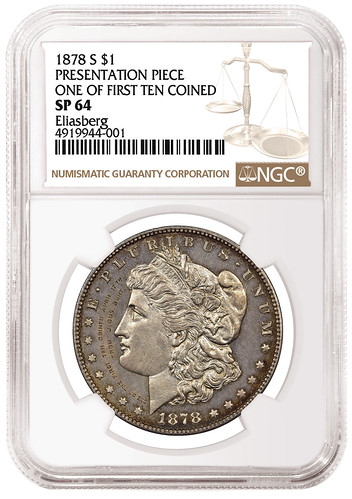
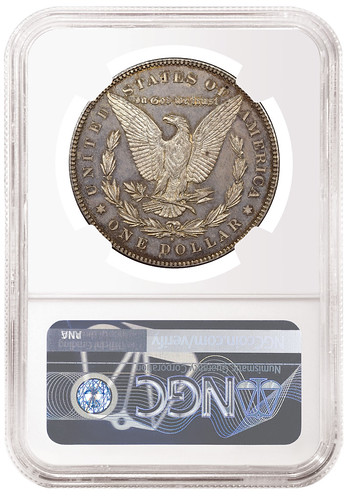
This incredible coin was struck from freshly polished dies and has an exceptionally strong strike with vivid cameo contrast between the design elements and the fields. The coin was clearly specially produced for the occasion and has thus been given the Specimen designation by NGC.
The coin's engraving is very similar to other engravings found on Morgan Dollars, such as the ones that appear on the first 1921 Morgan Dollars released from the Denver Mint. However, this appears to be the only 1878-S Morgan Dollar with such an engraving, which is also better executed than that seen on the 1921-D examples.
This 1878-S Morgan Dollar has a long pedigree. Its provenance can be traced back to Henry Chapman sale of the Emanuel Wertman Collection on November 19, 1910 in Philadelphia, where it apparently sold for a mere $1.10. It was later part of the famed Eliasberg Collection of US coinage.

"I have collected and studied Morgan Dollars for nearly four decades and this is one of the most amazing examples that I have ever seen," said Mark Salzberg, NGC Chairman and Grading Finalizer. "The coin is extraordinary, and I am honored that the owner chose NGC to certify it."
To read the complete article, see:
NGC Grades One of the First Morgan Dollars Struck in San
Francisco (https://www.ngccoin.com/news/article/7690/ngc-certifies-one-of-first-morgans-struck-in-san-francisco/)

STEPHEN ALBUM RARE COINS AUCTION 35
Here's the press release for Stephen Album Rare Coins Auction 35. Looks like a great sale! -Editor
Stephen Album Rare Coins will hold its Auction 35 on September 12-14, 2019 at its offices in Santa Rosa, California. The auction is comprised of exactly 2,800 lots of Ancient, Islamic, Chinese, General World, and Indian Coins, as well as a small selection of Numismatic Literature.
Some featured collections in the sale include; The Jerry D. Williams Collection of Elephant Coins & Medals, The Axel Wahlstedt Collection of Indian & East-Asian Coins, and The Christian Rasmussen Collection of Ilkhan Coins. The firm's CEO Joseph Lang has commented that, "This is probably one of our best catalogs. There are numerous interesting coins across all categories, many of which you will not find offered at other auction houses." Both internet and floor bidding are available for this sale. Some highlights from the sale follow:

LOT 175 - MUGHAL: Jahangir, 1605-1628, silver ½ rupee, Ahmadabad, AH1027 year 13, KM-138.2, zodiac type, Leo (lion left), with the sun rising behind, attractive original tone, an extremely rare denomination for this series, perhaps the only piece offered at public auction, PCGS graded EF40, RRRR, ex Dr. Axel Wahlstedt Collection Estimated Value $10,000 to $15,000
 LOT 269 - SIKH EMPIRE: gold mohurs (8
pieces), Amritsar, VS1843 year GN31x, group of 8 specimens of this extremely rare mohur of the Misl period, struck in the Bhangi Misl, centered at Amritsar, then under the rule of
Ghulab Singh Bhangi; the earliest known Sikh Empire coin struck in gold, attached to a necklace (the necklace itself is almost certainly not original), all in EF condition, lot of
8 coins attached to a necklace, RRR Estimated Value $14,000 - 16,000
LOT 269 - SIKH EMPIRE: gold mohurs (8
pieces), Amritsar, VS1843 year GN31x, group of 8 specimens of this extremely rare mohur of the Misl period, struck in the Bhangi Misl, centered at Amritsar, then under the rule of
Ghulab Singh Bhangi; the earliest known Sikh Empire coin struck in gold, attached to a necklace (the necklace itself is almost certainly not original), all in EF condition, lot of
8 coins attached to a necklace, RRR Estimated Value $14,000 - 16,000
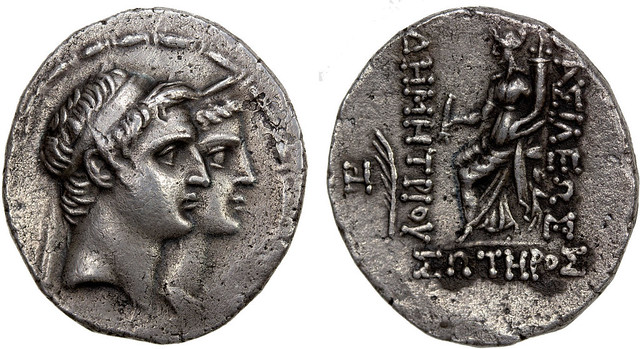
LOT 460 - SELEUKID KINGDOM: Demetrios I & Laodice IV, 162-150 BC, silver tetradrachm (16.24g), Seleukeia on the Tigris mint, SC-1686, struck circa 161-150 BC, jugate heads right of Demetrios, wearing diadem, and Laodice, wearing stephanos, within fillet border // Tyche holding scepter in extended left hand and cradling cornucopia in right arm, seated left on throne supported by tritoness right; monogram and palm frond to outer left, lovely quality for type! NGC graded choice EF, strike 5/5, surface 3/5, RRR Estimated Value $10,000 - 15,000
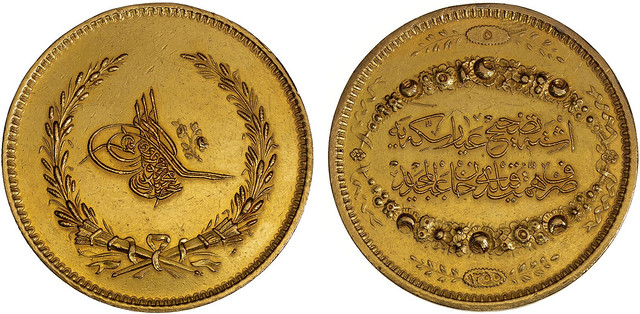
LOT 1096 - TURKEY: Abdul Mejid, 1839-1861, gold medal (90.92g), Kostantiniye, AH1255 year 5, cf. Pere 1087, cf. Sultan 3237, cf. Eldem pg. 154, 50mm, Commemorating the Establishment of the New Imperial Mint at Constantinople; tughra of Abdul Mejid at center; rose branch to right; all within grain-ear wreath with crossed quivers at base // iste tashihi ayar sikkaye sarfi himmet kildi hani ‘abd al-majid ("the amendment of setting coin to strike it the khan, Abdul Mejid") in Ottoman Turkish, all within floral wreath; above, regnal year on ornate tablet flanked by branches; below, Hejri date on ornate tablet flanked by branches, medal alignment, a few small reverse digs, mount very expertly removed, very bold strike, plain edge, EF, RRR Estimated Value $14,000 to $16,000

LOT 1669 - QING: Tong Zhi, 1862-1874, AE cash coin tree, Board of Revenue mint, Peking, Hartill-22.1125, East branch mint, intact cash coin tree (qianshu) of 38 coins, a lovely example! VF-EF, ex Master Sergeant L.B. Whittier Collection Estimated Value $10,000 - 15,000
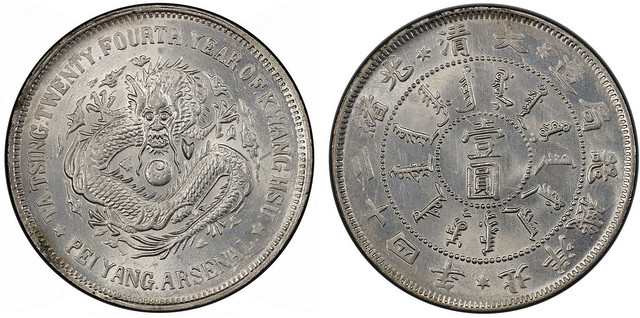
LOT 1725 - CHIHLI: Kuang Hsu, 1875-1908, silver dollar, Peiyang Arsenal mint, Tientsin, year 24 (1898), Y-65.2, L&M-449, dragon eyes in relief, a superb quality example with bright white original mint luster, PCGS graded MS63 Estimated Value $14,000 to $16,000
The firm is now taking consignments for its Auction 36 on January 23-25, 2020.
More information can be found on their website at www.stevealbum.com
LARGE HOARD OF NORMAN SILVER PENNIES FOUND
David Sundman shared this article from The Sunday Times about a great new find of Norman coinage. Thanks. He writes: "This is a very exciting find! This should enliven collecting of early English hammered coins." -Editor
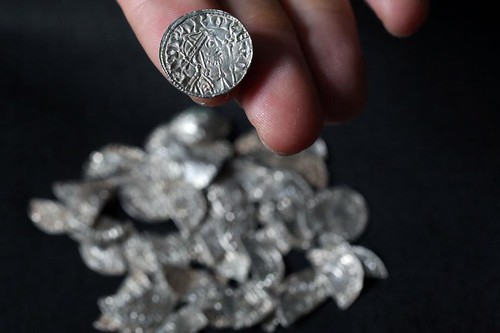 As thunder raged above a field in Somerset in January,
a couple worked for more than four hours in torrential rain to dig up one of the most significant coin hoards ever unearthed in Britain.
As thunder raged above a field in Somerset in January,
a couple worked for more than four hours in torrential rain to dig up one of the most significant coin hoards ever unearthed in Britain.
In 16 years of metal detecting together, Lisa Grace, 42, and Adam Staples, 43, from Derby, had found a number of precious items. Now they have discovered a vast collection of Norman treasure. The hoard of 2,528 coins has been described as "massively important" by experts at the British Museum, who said that it shed light on the transition between Anglo-Saxon and Norman rule and also revealed a 1,000-year-old form of tax evasion.
While teaching five friends how to use their new metal detectors, the couple found the silver pennies in a field near Chew Valley. About 1,200 of them bear the image of Harold II, the last crowned Anglo-Saxon king of England, and 1,300 bear that of William the Conqueror, who defeated him at the Battle of Hastings in 1066.
The museum said: "It is the largest Norman hoard found since 1833 and the largest ever found from the immediate aftermath of the Norman Conquest."
It shows that coins bearing Harold's image were still in use in the months after the conquest and that the Normans struggled with the Old English spelling of moneyers' names and local mints included on the coins. The find has trebled the number of Harold II coins known to exist and increased sixfold the number of early William I coins.
The value of the coins in the 1060s would have equalled the annual income of a whole estate, enough to buy 500 sheep. It was likely to have been buried for safe keeping by a landowner during the unrest that followed the conquest, possibly during the invasion of the region by Harold's sons in 1068.
Some of the coins were cut in half to get a smaller denomination, while conservators found the first example of a "mule" coin combining elements of Harold and William's coinage. Gareth Williams, curator of early medieval coinage at the British Museum, described this as "an early form of tax-dodging".
The hoard shows that one moneyer had worn out one of his William I dies, so used an old Harold II die, creating a coin with Harold's face on one side and William's inscription on the reverse. One coin combines dies from the reigns of William I and Edward the Confessor, Harold's predecessor. Those caught doing this risked losing a hand, but portraits of medieval kings were so stylised that they looked very similar.
They reported the find to the local coroner, as required by law, and it was taken to the museum. If the coroner rules, as is likely, that the find is "treasure", the Treasure Act states that a museum can acquire the hoard and offer a reward to the finders. Any proceeds will be split 50-50 between the landowner and detectorist group. Mr Staples said the couple would use their share to buy a home. The British Museum said the Roman Baths and Pump Room in Bath wanted the coins.
To read the complete article, see:
Detectorist couple unearth Norman tax dodge in Chew Valley
(https://www.thetimes.co.uk/article/detectorist-couple-unearth-norman-tax-dodge-in-chew-valley-26xtsdl5t)
Arthur Shippee passed along this BBC News news story and video. Thanks. -Editor
To read the complete article, see:
Detectorists find huge Chew Valley Norman coin hoard
(https://www.bbc.com/news/uk-england-somerset-49487078)
To watch the complete video, see:
'The coins just kept on coming and coming'
(https://www.bbc.com/news/av/uk-49504910/the-coins-just-kept-on-coming-and-coming)
MANY BRITISH COINS, BANKNOTES STILL UNREDEEMED
Dick Hanscom forwarded these two BBC News articles on progress in removing obsolete British coins and banknotes from circulation. Thanks. -Editor

Twenty four million old-style £1 coins have been returned to the Royal Mint over the last year.
But that still leaves 145 million outstanding - even though people have been unable to spend them in shops since October 2017.
The round £1 coin was replaced by the 12-sided version to help crack down on counterfeiting.
According to the Royal Mint, the round £1 coin can still be deposited at most high-street banks.
The new £1 coin was introduced on 28 March 2017, with one in 30 of the old version estimated to be fake according to the Royal Mint, a company wholly owned by the UK Treasury.
They added: "We expect there to be some returns for a number of years to come as people find these coins."
Millions of the round £1 coins have been melted down to help create some of the new ones at the Royal Mint, based in Llantrisant near Cardiff.
The new coin is described by the Mint as the most "secure in the world" and has a string of anti-counterfeiting details, including a hologram, and micro-sized lettering inside both rims.
It also has material inside which can be detected when electronically scanned by coin-counting or payment machines.
To read the complete article, see:
Old £1 coins: 145 million coins still not returned (https://www.bbc.com/news/uk-wales-49111748)

More than £1.5bn in old fivers and tenners has still not been cashed in more than a year after the last of them ceased to be legal tender.
The Bank of England says 118 million paper £5 notes and 94 million £10 paper notes have still not been returned.
The £5 notes were withdrawn in May 2017 and the £10 notes in March 2018, since when they have not been a legally accepted means of payment.
They can still be exchanged at face value from the Bank of England.
She said the shortfall in returned fivers was likely to be because, as notes of relatively low value, they were more likely to be lost or damaged - together with a desire to retain them as souvenirs.
To read the complete article, see:
More than £1.5bn of outdated £5 and £10 notes not returned (https://www.bbc.com/news/uk-49482401)

THE RISE OF CONDER TOKENS
A Stack's Bowers blog article by cataloger Jeremy Bostwick neatly summarizes the story of Britain's "Conder" tokens. -Editor

?The second half of the 18th century saw a sharp decline in the output of non-gold coinage by the Royal Mint in London, a situation that was exacerbated by the population boom and the move of many workers from rural farms to urban factories. With this influx of a new and growing workforce, employers had few options for paying employees, as there was a severe shortage of small change. Even worse, much of what was in circulation was counterfeit, accepted as payment simply because there was no other tangible solution.
In 1787, however, commerce would introduce an answer, with Thomas Williams overseeing the minting of copper halfpenny tokens as a means to compensate workers and facilitate trade locally on the Isle of Anglesey just off the coast of Wales. Within months, the effectiveness of privately issued token coinage was widely realized, as business leaders saw the benefits of solving a problem that the mint clearly was not. The next decade would see countless businesses commissioning and issuing their own token coinage, mostly in denominations of farthing, halfpenny, and penny that were vital to their working class employees.
These trade tokens featured seemingly endless design motifs meant, in some cases, to advertise a business or celebrate the locality for which the token was produced. So vast was the output that contemporary coin collectors became interested, attempting to track down every single variety or having their own produced for use as "trade bait" with fellow collectors. One such aspiring numismatist, James Conder, indexed the array of tokens he encountered, providing an early reference for other collectors and lending his name to the loose overall series of these trade tokens, now commonly referred to as 'Conder tokens.'
Our October Collectors Choice Online (CCO) auction will feature an attractive group of these trade tokens, the majority of which are in choice and gem grades and offer rich red-brown brilliance. Of note for the collector of architectural types is a run of issues struck for London and Gloucester by Peter Kempson, a button maker turned token manufacturer. The London series of penny tokens displays famous buildings in that city, such as the Bank of England, Middlesex Hospital, and the Royal Exchange, while the Gloucester series features structures such as Gloucester Cathedral, St. John's Church, and White Friars. Also popular with collectors—both in the time of James Conder and today—are those with animal motifs, such as James Pidcock's series. One of his more famous types, displaying a toucan and a two-headed cow, is also represented in this collection, along with numerous other fauna-inspired motifs.
To view these tokens along with the rest of our October Collectors Choice Online (CCO) auction—slated to be available online in late September—please visit StacksBowers.com, where you may register and participate in this sale.
To read the complete article, see:
The Rise of 'Conder Tokens' in Industrial England
(https://www.stacksbowers.com/News/Pages/Blogs.aspx?ArticleID=condor-toens-world-coins)
THE PITT REBUS CONDER TOKEN
An interesting Conder token is dealer Shanna Schmidt's Coin of the Week. The following is from her Newsletter #126, published August 31, 2019. -Editor

BRITISH TOKEN. Middlesex 290. London, Piccadilly. London Corresponding Society. 1796.
Æ halfpenny, 11.24g (29mm). Dies by Jacob made for Skidmore. A man hanging from a gallows, P(eye)T (A Pitt rebus) above the crossbar, a cap of Liberty on a pole behind, an obelisk inscribed 1796 on the upper part, PEACE on the lower part, a shield with an anchor and HOPE written above; symbols of religious and political power strewn on the ground below; LIBERTY AND NOT SLAVERY around / A circular legend around a LCS cypher; DEDICATED TO THE LONDON CORRESPONDING SOCIETY in the outer ring; MAY THESE ENDEAVORS MEET REWARD in the inner ring. Edge: Milled.
Pedigree: The Dr. Harry Salyards Collection. Ex Davisson 11/98. Ex Noble 1998
References: Dalton & Hamer, p. 127, 290
Grade: Uncirculated; prooflike; lightly toned (wc1051)
By the end of the 1700's the copper coinage for commerce in England was in a bad state. Coins for everyday purchases were in poor condition and counterfeits ran amok. This led to an ingenious innovation by the public. Tokens of similar size and quality were produced by merchants and private citizens and distributed as good currency for commerce. Over time there were so many tokens produced that finding one minted by the government was unlikely. The demand far exceeded the supply as people also began to collect them. Finally in 1797 the government intervened and produced the copper two penny and one penny pieces.
Many people know these tokens as "Condor" tokens. This was because a man named James Condor of Ipswich published an arrangement of the tokens in 1798, just one year after the introduction of the new government issues. There are thousands of tokens out there and the fun in collecting all of them would be a lifelong project.
To read the item description, see:
British Token, Middlesex 290. London,
Piccadilly. London Corresponding Society. 1796
(https://www.shannaschmidt.com/world/british-token-middlesex-290-london-piccadilly-london-corresponding-society-1796?rq=wc1051)
MORE ON THE 'LET THE E[A]GLE FLY' TOKEN


 Tony Terranova forwarded
the above images (crudely edited by me) of an 1846-dated token with an eagle of a similar style to that on the "Let the E[a]gle Fly" piece (right) that Dave Bowers asked
about in our August 4, 2019 issue.
Tony Terranova forwarded
the above images (crudely edited by me) of an 1846-dated token with an eagle of a similar style to that on the "Let the E[a]gle Fly" piece (right) that Dave Bowers asked
about in our August 4, 2019 issue.
Tony had no other information on his piece. In a multiparty email exchange the following week several facts and theories surfaced and Dave continued compiling notes for his research. He also purchased the piece from Tony, who delivered it to Dave at the recent ANA World's Fair of Money in Rosemont. Dave released a summary of the work to date and a call for further information in an August 22, 2019 Stack's Bowers blog article. -Editor

Several weeks ago I invited readers to contact me about a curious token that has puzzled me and others for a long time. The inscription reads: LET THE EGLE FLY / J.S.G.S.L.C.O. The reverse shows an eagle vertically, without legs or talons, with a shield on its breast. Seven stars are above. Below the eagle are seven stars, the date 1846, and 2 more stars.
Douglas Nyholm, well-known Salt Lake City numismatist and author, has checked with historians at The Church of Jesus Christ of Latter Day Saints and has found that there is no official connection between this token and the church. That eliminated one avenue of research. Robert D. Leonard. Jr. (Bob) has given me valuable ideas and pedigrees of known examples. This information reduces my earlier estimate of more than a dozen known to just a handful. William Hyder directed me to the sun stones of Nauvoo with a design similar to the face of the token. Dr. J.M. Galst also shared information.
This led me to learn of two related varieties, one of which has a Liberty Head on the obverse (the design of the 1795-1807 $5 gold coin) with 11 stars and the date 1846, and with an eagle reverse similar to the foregoing, but with the stars differently arranged and without the date 1846.
If any readers of this blog own any of these tokens or have images of them to share, e-mail me. Bob Leonard and I will add them to the present censuses. I will be gathering more information in coming weeks that may lead to a small book on these tokens and various Mormon notes and coins.
Dave can be reached at qdbarchive@metrocast.net .
Numismatic research takes time. It will be interesting to see where this leads and as always, we'll look forward to Dave's next book. -Editor
To read the complete blog article, see:
Revisiting the Enigmatic "Let the Egle Fly" Token
(https://www.stacksbowers.com/News/Pages/Blogs.aspx?ArticleID=revisiting-the-eagle)
To read the earlier E-Sylum article, see:
QUERY: TWO ENIGMATIC TOKEN INSCRIPTIONS (https://www.coinbooks.org/v22/esylum_v22n31a13.html)
THEODORE N. VAIL AND THE U.S. POSTAL SERVICE
In my Numismatic Diary last week I mentioned Benjamin Rush and the founding of the U.S. Postal Service. Harry Waterson kindly submitted this article on another public figure prominent in the history of the USPS. Thanks! -Editor


Theodore N. Vail Medal for Noteworthy Public Service
The portrait of Theodore Vail on the obverse shows the telephone pioneer in his prime. He was president of the American Telephone and Telegraph Company from 1907 until his retirement in 1919. He died in 1920 at the age of 74. He had a long and honored career. His guiding principle, that customer service was more important than increasing dividends, was the foundation of AT&T. There is this famous quote that sums up Theodore Vail. "Alexander Graham Bell invented the telephone. Theodore Vail invented the telephone business."
This medal was designed by Adolf Weinman in 1921. Weinman designed the Walking Liberty Half and the Liberty Dime. The Vail Memorial Medal was awarded to employees for noteworthy acts reflecting the Bell Telephone System's highest traditions of loyalty and devotion to duty. Gold, silver and bronzes medals struck by Medallic Art Co. were awarded in the hundreds from 1921 to 1984 when the Bell System was broken up.
The central figure on the reverse represents the "Civilizing Force of Communication." speeding the winged message along the wires. At the right, "Loyalty to Service" upholds the left hand of the central figure, while a third figure, "Devotion to Duty" helps to support the lines of communication. Wearable gold charms for women and lapel pins for men were awarded.
The above entry was part of a presentation I did for the Ozarks' Coin Club in June.
My godmother worked for Bell Labs in lower Manhattan and she wore a tiny gold charm of the obverse of the above medal. She never explained it. That forced me to be aware of Mr. Vail. In light of your interest last week in the USPS I thought I would add this to that thread from Wikipedia and Telcomhistory.org
In the Spring of 1869, Theodore Vail was appointed clerk of the railway mail service between Omaha and Ogden. His success in getting the mail through during the snow blockage of 1870, came to the attention of upper management.
He was promoted to the Chicago and Iowa City railway post office, an important distribution point at the time. When the railway post office was established on The Union Pacific, Vail was promoted to head clerk.
In March, 1873, Vail was assigned to duty in the office of the General Superintendent of Railway Mail Service, Washington, D.C. There he exercised special oversight of distribution of the mails, and justified to Congress the compensation the railways received for carrying the mail. In June, 1874, he was appointed Assistant Superintendent of Railway Mail Service. In 1875, he became Assistant General Superintendent.
In February, 1876, Vail was appointed General Superintendent after his boss retired. He had reached the highest grade attainable in this branch of the Federal government. He was the youngest officer in the Railway Mail Service, both in years and terms of service. When this final appointment was made by the Postmaster General, the latter said that his only objection to Vail was his youth.
As General Superintendent, Vail helped put postal employees under the general civil service laws. He established the system of six months' probationary appointments, which were subsequently adopted by all agencies.
This was the judgment of his peers: He went to work for the U.S. Postal Railway System as a mail clerk. From the very beginning on this job, he began to develop the mail delivery system used to this day by the U. S. Postal System. His system allowed mail to be delivered up to two weeks earlier than was done before. He initiated schematic distribution in the West, and within 6 years expanded the system to include the vast network of rails throughout the country.
Perhaps the finest tribute to Vail was that his success was met with almost no resentment or jealousy, but rather an outpouring of sincere warmth and congratulations from peers and coworkers. They felt "he faithfully earned the laurels won, and hoped to hear of his continued recognition, believing he belonged further up the scale."
And, then, he went to the phone company. .
Very interesting! I didn't know that about Vail. Amazing. I started my career at Bell Labs in New Jersey, a few years before the AT&T breakup. I knew nothing of Vail then, but numismatics has filled in the gaps in my knowledge. Thanks again. -Editor
To read earlier E-Sylum articles, see:
1925 THEODORE N. VAIL MEMORIAL MEDAL (https://www.coinbooks.org/esylum_v17n25a10.html)
WAYNE'S 2019 ANA DIARY: PART II : Rush's Thunder Clappers
(https://www.coinbooks.org/v22/esylum_v22n34a20.html)
THE GREAT BOOK SCARE
There are plenty of studies around that discuss substances, diseases and miscellaneous filth to be found on coins and banknotes, but if you want something else to be afraid of, Smithsonian magazine published an article on The Great Book Scare. Here's an excerpt - see the complete article online for more images and craziness. -Editor
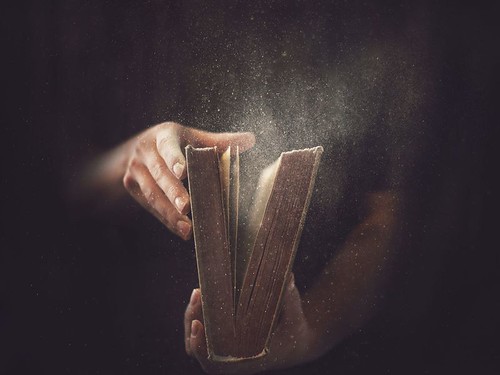 On September 12, 1895, a Nebraskan named Jessie Allan
died of tuberculosis. Such deaths were a common occurrence at the turn of the 20th century, but Allan's case of "consumption" reportedly came from an unusual source. She was a
librarian at the Omaha Public Library, and thanks to a common fear of the time, people worried that Allan's terminal illness may have come from a book.
On September 12, 1895, a Nebraskan named Jessie Allan
died of tuberculosis. Such deaths were a common occurrence at the turn of the 20th century, but Allan's case of "consumption" reportedly came from an unusual source. She was a
librarian at the Omaha Public Library, and thanks to a common fear of the time, people worried that Allan's terminal illness may have come from a book.
Allan's death occurred during what is sometimes called the "great book scare." This scare, now mostly forgotten, was a frantic panic during the late 19th and early 20th centuries that contaminated books—particularly ones lent out from libraries—could spread deadly diseases. The panic sprung from "the public understanding of the causes of diseases as germs," says Annika Mann, a professor at Arizona State University and author of Reading Contagion: The Hazards of Reading in the Age of Print.
Librarians worried that Allan's death, which became a focal point of the scare, would dissuade people from borrowing books and lead to a decline in support for public libraries.
"Possibly there is some danger from this source; since the bacillus was discovered danger is found to lurk in places hitherto unsuspected," the Library Journal continues. "But the greater danger, perhaps, comes in over-estimating this source of danger and frightening people into a nervous condition."
Books were viewed as possible vehicles of disease transmission for several reasons. At a time when public libraries were relatively new, it was easy to worry about who had last handled a book and whether they might have been ill. Books that appeared to be benign might conceal diseases that could be unleashed "in the act of opening them," Mann says. People were concerned about health conditions caused by "inhaling book dust," Greenberg writes, and the possibility of "contracting cancer by coming in contact with malignant tissue expectorated upon the pages."
In response to the panic, libraries were expected to disinfect books suspected of carrying diseases. Numerous methods were used for disinfecting books, including holding the books in vapor from "carbolic acid crystals heated in an oven" in Sheffield, England, and sterilization via "formaldehyde solution" in Pennsylvania, according to Greenberg. In New York, books were disinfected with steam. A study in Dresden, Germany, "revealed that soiled book pages rubbed with wet fingers yielded many microbes."
After much tribulation, reason eventually took hold. People began to question whether infection via books was a serious threat or simply an idea that has been spread through public fears. After all, librarians were not reporting higher illness rates as compared to other occupations, according to Greenberg. Librarians began to address the panic directly, "trying to defend the institution," Mann says, their attitude characterized by "a lack of fear."
In New York, political attempts during the spring of 1914 to have books disinfected en masse were roundly defeated after objections from the New York Public Library and a threat of "citywide protest." Elsewhere, the panic began to subside as well. Books that were previously thought to have been infected were lent again without further issue. In Britain, experiment after experiment by doctors and hygiene professors reported next to no chance of contracting a disease from a book. The panic was coming to an end.
To read the complete article, see:
When the Public Feared That Library
Books Could Spread Deadly Diseases (https://www.smithsonianmag.com/history/during-great-book-scare-people-worried-contaminated-books-could-spread-disease-180972967/)
BRISBANE ARTIST RYAN PRESLEY'S BLOOD MONEY ART
In February we discussed the work of Australian artist Ryan Presley, who had created an installation at Sydney's Museum of Contemporary Art called The Blood Money Currency Exchange Terminal.
Andrew Crellin of Sterling & Currency in Fremantle, Western Australia published a blog post August 31, 2019 about the artist's work. Here's an excerpt. See the earlier article in this issue for information on ordering the book based on the installation. -Editor

A few months ago (mid-2019 as I write this), I came across a series of social media posts about an event held in Sydney between January 21st and January 28th 2019 by a Brisbane artist and academic that used banknote designs and what I understand was an art installation at the Museum of Contemporary Art (smack bang on Sydney Harbour) where the public could exchange banknotes for limited edition $10, $20, $50 and $100 "Blood Money Dollar" prints.
I believe the whole idea of Presley's efforts behind this project can be summed up by this quote: "People take for granted having money in their pocket, but they don't think about what that represents."
For mine, Presley's project is literally another interpretation of images, art and subjects that many of us accept without question.
As a dedicated numismatist, I reckon Presley's project is a fantastic example of how currency (banknote designs in this case) acts as a medium of artistic expression. In Australia, that artistic expression is obviously primarily restricted by the Commonwealth Government to officially-sanctioned artists that have been subjected to a lengthy and rigorous process that ensures the resulting designs are squeaky clean and meet the social objectives that the government has for our currency.
If we think back to the social media sh*tstorm that erupted over the innovative designs used on the Next Generation $5 note when it was released in 2016, and the massive lather that the twitterati got into about the spelling mistake discovered on the NGB $50 earlier this year, we can appreciate just how much scrutiny our banknotes can be subject to.
Without even knowing one thing about the ideas behind Presley's project, his approach of using the basic structure of the designs seen on our circulating polymer notes to explore the impact that white settlement had on indigenous Australians generally, and a specific series of indigenous heroes and warriors specifically, immediately feels provocative and subversive.
Presley's series of artworks is titled "Blood Money", and has been published in a hard-covered book by the Institute of Modern Art in Brisbane. Not only does this book explore the themes behind the designs that Presley has chosen, but it also features four chapters by academics that cover a range of related subjects such as the role that money played in displacing Australia's indigenous population and strengthening the institutional power that white settlers and the colonial government assumed.
Other chapters discuss the role that money plays in society; and the nature of Australia's colonial economy.
Dealing as it does with subjects as visceral as displacement; subjugation and even genocide, Presley's art and related installation is clearly confronting without ever projecting blame or anger.
I believe any numismatist that has an interest in colonial coinage and currency notes, or even our current circulating banknotes will really enjoy the effort Presley has gone to in using his artwork to express the ideas he is looking to raise.
His attention to detail regarding the way in which our contemporary banknotes are designed is clear, as is his understanding of the mechanics of Australia's colonial economy, from the coins and notes that were used right through to the control over our circulating notes that the Commonwealth Government assumed following Federation.
I'd love to see the "Blood Money" installation at a future ANDA Money Expo, I believe it'd be a great way for us collectors to get an alternative view not only on the designs we see on the notes we use each day, but also the stories of Australia's colonisation.
To read the complete article, see:
BLOOD MONEY - USING ART AND
AUSTRALIA'S BANKNOTES TO KICK OFF DISCUSSION OF INDIGENOUS STORIES
(https://www.sterlingcurrency.com.au/blog/news-research/the-fine-art-of-numismatics/blood-money-using-art-and-australias-banknotes-to/)
To read the earlier E-Sylum article, see:
AUSTRALIAN ARTIST'S BLOOD MONEY NOTES (https://www.coinbooks.org/v22/esylum_v22n05a32.html)

